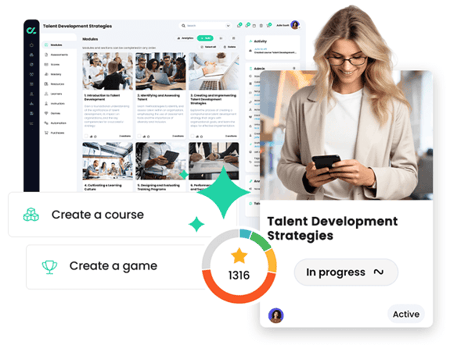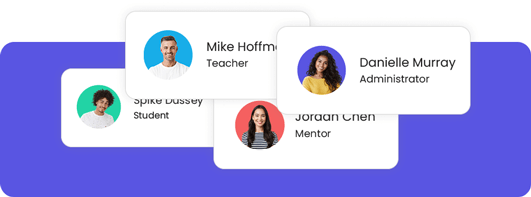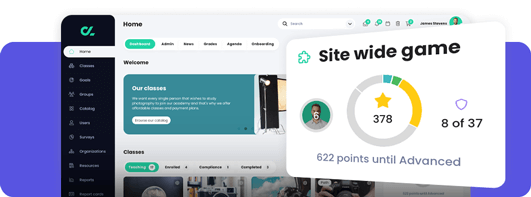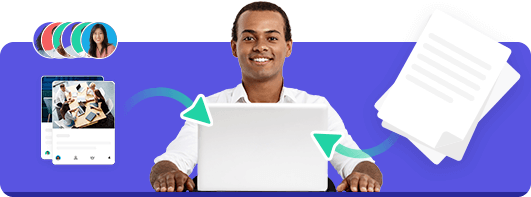What is an LMS?
The complete guide to modern Learning Management Systems

A Learning Management System (LMS) is software designed to create, deliver, manage, and track training and educational programs. It centralizes learning activities, enhances user experience, and improves efficiency for both educational institutions and corporate environments. This guide explains everything you need to know about what an LMS is and how it can move the needle on accelerating your learning or training goals.
Big picture takeaways
A chosen LMS centralizes management, delivery, and tracking of educational and training activities, improving processes for both educational institutions, enterprise orgs, and many other businesses and companies.
Key features of an LMS include course management, user management, compliance tracking, and advanced analytics, which collectively enhance learning experiences and operational efficiency.
The growing demand for LMS technology signals an increased focus on personalized learning experiences, integration with existing tech stacks, and the adoption of innovative features like AI and immersive learning tools.
What is an LMS?
At its core, a Learning Management System (LMS) is a software tool designed for creating, delivering, and reporting on training activities. It serves a broad category of users, including educators in schools and universities, as well as corporate trainers in businesses.
LMS platforms offer a structured framework that supports a variety of learning programs, from mandatory compliance training to advanced skill development courses, utilizing a software platform.
Additionally, LMS platforms aren't confined to one type of organization. They are utilized in education and corporate environments, each adapting the technology to meet their unique training needs. From personalized learning paths to comprehensive analytics, an LMS provides a range of features that cater to various learning and development requirements.
LMS vs LXP vs LCMS
Understanding the differences between an LMS, a Learning Experience Platform (LXP), and a Learning Content Management System (LCMS) is crucial. While an LMS focuses on managing, tracking, and delivering e-learning materials, an LXP emphasizes personalized learning and content discovery based on user interests.
An LCMS, on the other hand, is useful for content creation and collaborative development. This third option makes it easier to create, store, and organize online training materials.
The history behind LMS platforms
💡Did you know? The concept of Learning Management Systems dates back to the 1960s and 1970s when computers were first used for military and scientific training applications. The evolution continued with the development of computer-based training systems in the 1980s and the introduction of web-based training in the 1990s.
The launch of Moodle (the first open-source Learning Management System) in 2002 marked a major turning point, empowering users to customize and control their learning environments like never before. Since then, LMS technology has advanced quickly and competitively.
Award-winning platform

















Choose an award-winning platform like CYPHER Learning to improve your learning outcomes and employee engagement.
Today’s systems are smarter and more adaptive (often thanks to the use of generative artificial intelligence). They integrate cutting-edge features like gamification, mobile accessibility, and personalized learning paths to meet the evolving needs of modern learners.
What are the key components of an LMS?
An effective LMS comprises several key components, including:
- Course management, which helps structure, organize, and distribute training content efficiently
- User management features, which allow administrators to add or remove users and manage permissions, ensuring data integrity and security
- Analytics, which provide insights into user engagement and learning outcomes
This combination of features ensures a comprehensive training Learning Management System. Analytics and reporting capabilities provide insights into learner progress and course effectiveness, enabling continuous improvement.

Features and tools: How LMS platforms work
A well-designed LMS always makes it easier to deliver content, track progress, and keep learners engaged. The right solution also scales with your needs, offering tools that support everything from onboarding to ongoing development.
While content and platforms vary, here’s a general look at what you can expect:

Content management and authoring are critical components of an LMS. These platforms allow instructors to create and deliver diverse content types, including multimedia elements, assessments, and interactive modules. Built-in authoring tools make it easier to create engaging digital learning materials, while integrations with other software enhance functionality in daily workflows.

Robust user management features in an LMS allow administrators to control access based on roles, ensuring relevant content is available to the right users. Role-Based Access Control (RBAC) is commonly used to assign permissions based on roles, enhancing security and operational efficiency.
Compliance tracking is a vital feature of some LMS platforms, ensuring users meet industry regulations and certification requirements. These systems track learner progress against compliance standards and automate enrollment and notifications, keeping employees aware of their training obligations.

Analytics tools in an LMS provide insights into learner performance, helping organizations identify areas for improvement. Real-time reporting capabilities also allow administrators to track learner progress and adjust training strategies promptly. By gaining clarity on ROI through solid reporting, you’ll be in a better position to scale new initiatives—and know which ones deliver maximum benefit to teams and the organization at large.
Accurately capture and track user engagement by recording time spent on each section and assignment. Ideal for accreditation and clock hour industries as well as corporate compliance, this feature ensures precise tracking of user participation and course effectiveness. With CYPHER, you’ll have access to built-in, customizable reports that provide valuable learner data in just a few clicks.

Gamification elements, such as points, badges, and leaderboards, are integrated into LMS platforms to boost learner engagement and motivation. These features transform traditional learning tasks into interactive immersive experiences, making complex subjects easier to grasp and more enjoyable.
Recap: Core LMS features
In summary, here's what the best modern LMS platforms bring to the table:
Upload, organize, and distribute learning materials with ease, whether you're sharing videos, documents, or interactive modules.
Know who’s engaging, how often, and how well. Track progress, identify knowledge gaps, and support learners at every stage.
Get clear, real-time insights into performance and completion rates so you can refine your training programs with confidence.
Whether it’s self-paced modules, live instructor-led training, or blended learning, the platform should flex to fit how your team learns best.
Behind the scenes: How an LMS functions
Learning Management Systems offer a structured student learning experience that can support both extensive educational programs for large groups and focused training for smaller teams, making them some of the best Learning Management Systems available. Learning Management Systems work as a training management system can enhance this process further.
LMS architecture and integrations
An effective LMS architecture supports seamless integrations with various tools, allowing for efficient data sharing and enhanced learning experiences. Integrations can connect the LMS with existing software tools in a company’s tech stack, improving user experience and operational efficiency.
⭐ How does CYPHER integrate? We’re glad you asked! Our complete set of LMS integrations are built-in and powerful. Connect quickly to common tools like Google Drive and MS Teams, or enhance your learning security with single-sign on (SSO) and other valuable connections.
SCORM, xAPI, and learning standards
SCORM and xAPI are standards that ensure interoperability between e-learning software, facilitating the sharing and tracking of learning activities across different platforms. SCORM allows any SCORM-compliant LMS to run SCORM content seamlessly, while xAPI expands tracking capabilities to include diverse learning experiences beyond traditional e-learning environments.
Read more: 12 types of reports you need for e-learning
Cloud-based versus on-premise
Cloud-based LMS platforms offer greater flexibility and accessibility compared to self hosted lms systems, which may require substantial IT resources for maintenance. Cloud LMSs typically operate on a subscription model, offering automatic updates and vendor-managed maintenance, while on-premise LMSs are hosted on the institution’s own servers.
Notably, the global LMS market is projected to grow from $28.58 billion in 2025 to $70.83 billion by 2030, signaling strong momentum behind cloud-based adoption. This surge reflects the growing demand for scalable, maintenance-free solutions that support hybrid and remote learning environments.
Business benefits of using an LMS
Learning Management Systems provide numerous advantages for businesses, including time and cost savings. An LMS enhances employee engagement by offering consistent learning opportunities, leading to improved performance and productivity.
Here are the main benefits of using an LMS
Boosts learner engagement, employee productivity, and performance
Easily track learner progress at each stage of the learning process - easily upskill, reskill, cross-skill
Trainers, instructors, managers, leaders, and teachers save time - tasks can be automated
Enable learners to learn at their own pace - just in time, just for them, just the way they want it
The #1 choice learning platform to train employees, customers, partners - extended enterprise
Reduces costs by simplifying your tech stack and accelerating your workflow
Continuous training through an LMS also increases job satisfaction, continuous learning, and employee retention, fostering a continuous learning culture.
Using an LMS significantly reduces the costs associated with traditional learning methods, such as in-person training, travel, and materials. The reusability of training content in an LMS means there’s no need to pay for the same training twice, saving both time and money.
LMS platforms facilitate training for remote learners, allowing them to access training anytime and anywhere. These systems support a variety of devices, including mobile devices, making it easier for learners to engage with training materials on the go for flexible learning.
An LMS streamlines and centralizes training management, making it easier to manage various training programs in one platform. This centralized management ensures that training is kept current and relevant, preparing employees for career advancement and improving retention rates.
Social learning
Social learning is a key feature of modern LMS platforms that promotes collaboration, knowledge-sharing, and peer engagement. Tools like discussion forums, chat, and shared workspaces allow learners to interact, ask questions, and exchange insights—mirroring the dynamics of a traditional classroom.
CYPHER includes plenty of collaborative, socially-inspired features to get learners and instructors talking. Exchange ideas, build upon helpful translations, and revamp your community approach to professional development.
This type of community-driven approach reinforces course content, boosts engagement, and helps employees apply learning in real-world scenarios. It also builds a stronger learning culture by encouraging mentorship and continuous improvement.
Popular LMS use cases for business, education, and beyond
LMS platforms empower new employees by providing them with the necessary resources and confidence to settle quickly into their roles. They also boost engagement and completion rates in learning and development programs, leading to improved employee performance.
LMS platforms are extensively used in employee training programs for various needs, including compliance training and skills development. They offer personalized learning experiences and track progress, ensuring employees receive the training they need to succeed in their roles.
Compliance training often includes specific modules tailored to various regulations, such as sexual harassment awareness, ensuring employees understand legal requirements. Using an LMS for compliance training helps centralize all training materials and track employee progress, reducing the risk of noncompliance and associated legal issues.
Using an LMS for customer education can enhance product adoption by providing structured training resources that cater to various learning styles. Effective customer education programs ensure users understand the full value of a product, leading to long-term engagement and brand advocacy.
Franchise LMS platforms centralize online training, ensuring consistent delivery and tracking across multiple locations. These systems can be tailored to address regional training needs, promoting brand consistency and operational efficiency.
Corporate training programs often leverage corporate lms platforms to rapidly produce role-specific onboarding programs that engage new hires effectively. LMS platforms provide access to training anytime, on various devices, essential for onboarding and continuous skill development. They also help meet legal and regulatory requirements through organized compliance training.
Many academic and higher education institutions utilize LMS platforms to support a blended learning strategy and online course delivery. These platforms enable educators to create a range of immersive learning experiences using technologies such as augmented reality, virtual reality, and AI.
An enterprise LMS can reach a diverse range of learners, including partners, suppliers, resellers, and customers. By providing specialized product training, companies can reduce customer churn and increase engagement, fostering stronger relationships and community building.















Why should you start using an LMS?
An LMS is an essential learning platform that can improve training, skill development, performance, and engagement in business, schools, and higher education.
Choosing the right LMS for your needs
Choosing the right LMS starts with a clear understanding of your organization’s unique training needs. Aligning platform features with your goals and learning objectives lays the groundwork for a smooth, successful rollout. Bringing in a focused implementation team can make all the difference—helping you stay organized, avoid common pitfalls, and get the most value from your investment.
An effective LMS should support content management, user management, and provide robust reporting capabilities. When choosing an LMS, focus on these essential features:
- Content management – Upload, organize, and update courses with ease
- User and role management – Control access and group learners by team or function
- Analytics and reporting – Track progress, scores, and completion rates
- Mobile access – Let users learn from any device, anytime
- Compliance tracking – Automate certifications and audit logs
- Integrations – Sync with your HR, CRM, and other tools
Define your priorities up front so you can focus on platforms that check the right boxes.
Watch out for these common pitfalls when evaluating LMS platforms:
- Weak customer support – Delays and unresponsive service can derail implementation
- Overloaded with features – More isn’t always better—too many tools can overwhelm users and inflate costs
- Poor user experience – Clunky interfaces frustrate learners and reduce engagement
- Lack of alignment – If it doesn’t match your goals or workflows, even a powerful LMS can fall flat
Stick to platforms that serve your actual needs without adding unnecessary complexity.
Emerging trends in LMS technology
The global market for Learning Management Systems is projected to reach $25.7 billion in 2025, indicating a growing demand for white glove LMS solutions and experiences. Modern LMS platforms are designed to enhance user engagement through interactive content and user-friendly interfaces.
AI-enabled LMS platforms leverage machine learning and natural language processing to automate tasks such as speech recognition and adaptive assessments. These systems provide personalized learning experiences by analyzing user data and recommending relevant courses tailored to individual needs.
LMS providers are integrating augmented reality and virtual reality to create more interactive and engaging educational environments. Instructors utilize these technologies to develop learning experiences that simulate real-world scenarios, enhancing learner engagement.
Implementing your LMS—successfully and quickly
Successful LMS implementation requires careful planning and preparation. Engaging stakeholders during the planning phase ensures that their needs are met, leading to a smoother implementation process. Training and support are crucial for user adoption, with regular customer training sessions enhancing familiarity and confidence with the platform, as we deliver training effectively using various training methods, including partner training.

A customer success representative should review everything before the LMS launch to ensure readiness. Engaging stakeholders during the planning phase ensures that their needs are met, leading to a smoother implementation process.

Regular training sessions help users become familiar with the LMS and enhance their confidence. Providing adequate training and support is crucial for successful LMS adoption, ensuring users can navigate the platform effectively during the learning process.
Evaluating the impact of your LMS goes beyond tracking who finishes a course. Instead, focus on outcomes that reflect real growth, behavior change, and business value. Look for:
- Skill application on the job – Are employees applying what they’ve learned in meaningful ways?
- Time-to-productivity – How quickly are new hires ramping up with the help of training?
- Knowledge retention and recall – Is learning sticking over time, not just post-assessment?
- Team performance improvements – Are training initiatives driving measurable gains in productivity or efficiency?
- Feedback loops – What are learners and managers saying about relevance and usability?
These success signals give a clearer picture of how learning drives real-world outcomes—not just checkboxes.
Frequently asked questions (FAQ)
This section answers common questions about LMS, providing clarity on various aspects of the technology and its implementation.
An LMS primarily focuses on structured learning and is widely used for managing formal training and compliance requirements.
An LXP is designed for a more personalized learning experience, allowing learners to access content based on their interests and engage in social learning throughout their learning journey.
An LCMS specializes in content creation and management, providing tools for collaborative content development and efficient organization.
AI-enabled LMS platforms leverage machine learning and natural language processing to automate tasks such as course creation and adaptive assessments. These systems provide personalization by analyzing user data and recommending relevant courses tailored to individual needs, enhancing the overall learning processes.
AI in LMS enhances engagement through gamification elements, making learning more interactive and enjoyable for users.
Public sector organizations use LMS to manage diverse workforce training and ensure compliance with regulations. The medical industry utilizes LMS for managing staff certifications and ensuring compliance with healthcare training regulations.
Educational institutions implement LMS to enhance learning experiences through traditional educational methods, blended learning, and streamlined administrative tasks.
Learning Management Systems streamline compliance training by automating employee enrollment in mandatory programs, reducing the risk of missed training. Reporting features in LMS platforms allow tracking of training completions and assessment results, creating automated audit trails for compliance verification.
Integrating an LMS with other business systems enhances training efficiency by allowing seamless data transfer and reducing manual entry of information. Effective LMS integration fosters a more intuitive learning experience by connecting various tools, making it easier for employees to access training resources in their daily workflows.
The overall expenses associated with an LMS include initial setup and ongoing maintenance costs, which can vary significantly based on the chosen system. Factors impacting the cost of an LMS include the number of active users, the extent of needed customization, and the features and functionalities required.
The return on investment (ROI) from an LMS can be calculated by assessing both revenue generation and cost savings attributable to improved employee performance and productivity. Key metrics such as reduced training costs, increased employee retention, and enhanced productivity should be compared against initial goals to evaluate the ROI of an LMS effectively.
Wrapping Up: Why the right LMS matters
A modern LMS is a strategic tool for growth. The right one can empower your team to learn faster, retain more, and apply knowledge in ways that drive real, verified business impact. As online learning continues to evolve, organizations need flexible, future-ready solutions that align with goals and integrate seamlessly into current workflows. Whether you're training employees, onboarding new hires, or supporting compliance efforts, choosing the right LMS makes all the difference.




